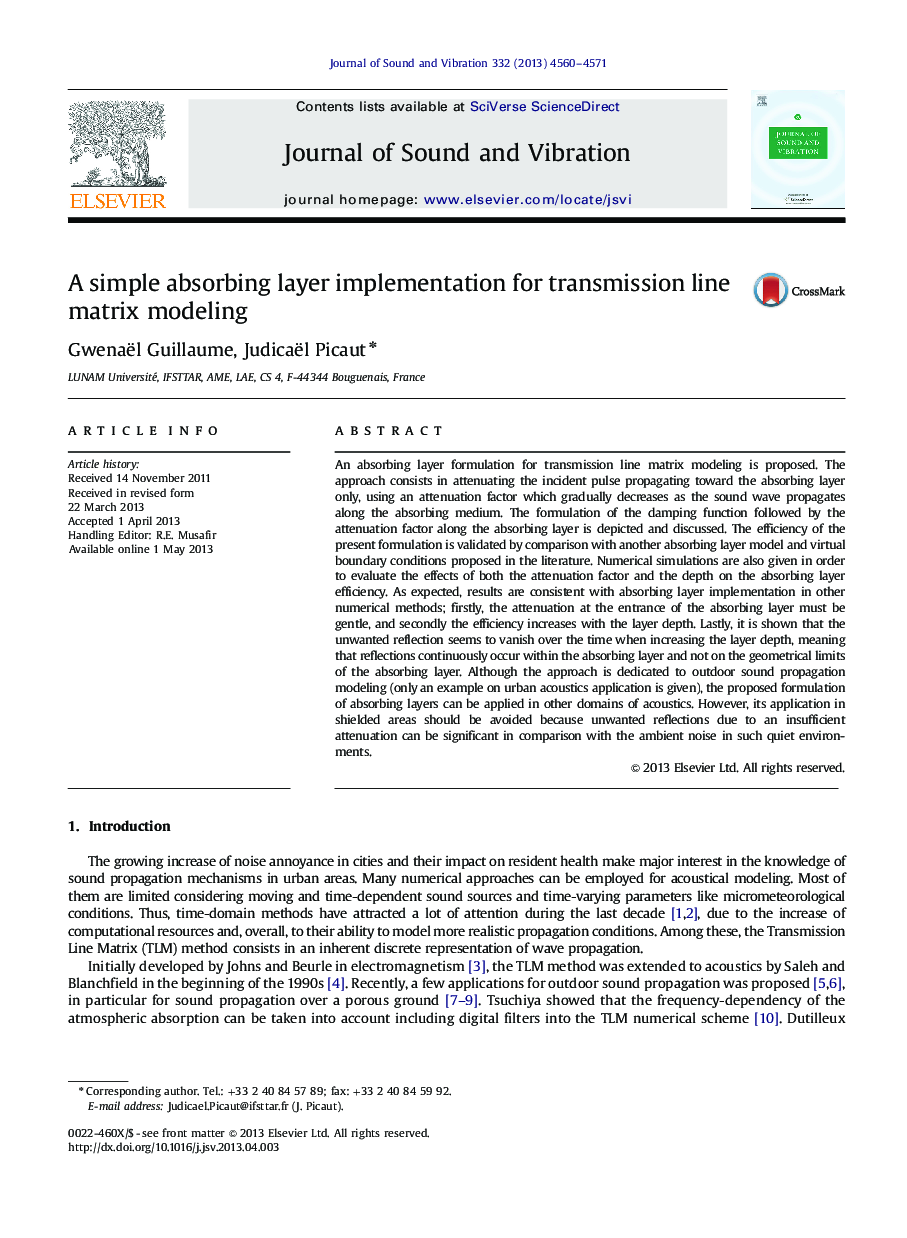| کد مقاله | کد نشریه | سال انتشار | مقاله انگلیسی | نسخه تمام متن |
|---|---|---|---|---|
| 10289219 | 509584 | 2013 | 12 صفحه PDF | دانلود رایگان |
عنوان انگلیسی مقاله ISI
A simple absorbing layer implementation for transmission line matrix modeling
ترجمه فارسی عنوان
پیاده سازی ساده لایه جذب برای مدل سازی ماتریس خط انتقال
دانلود مقاله + سفارش ترجمه
دانلود مقاله ISI انگلیسی
رایگان برای ایرانیان
ترجمه چکیده
فرموله سازی لایه جذب برای مدل سازی ماتریس خط انتقال پیشنهاد شده است. این رویکرد شامل تضعیف پالس حادثه تنها به سمت لایه جذب می شود، با استفاده از یک عامل افتادگی که به تدریج کاهش می یابد به عنوان موج صدا منتشر در امتداد وسیله جذب می شود. شکل گیری عملکرد تضعیف و ضعف در طول لایه جذب، نشان داده شده و مورد بحث است. کارایی فرمول فعلی با مقایسه با یک مدل لایه جذب کننده و شرایط مرزی مجازی در ادبیات معتبر است. شبیه سازی عددی نیز برای ارزیابی اثرات هر دو عامل کاهش و عمق بر کارایی لایه جذب داده شده است. همانطور که انتظار می رود، نتایج با استفاده از جذب لایه در سایر روش های عددی سازگار است؛ در ابتدا، محو شدن در ورودی لایه جذب کننده باید ملایم باشد، و در نتیجه، کارایی با عمق لایه افزایش می یابد. در نهایت، نشان داده شده است که بازتاب ناخواسته در طول زمان افزایش عمق لایه، به معنی آن است که بازتابها به طور مداوم در داخل لایه جذب رخ می دهند و نه در محدوده هندسی لایه جذب. اگر چه این رویکرد به مدل سازی پخش صدا در فضای اختصاص یافته است (فقط یک مثال در مورد کاربرد آکوستیک شهری داده شده است)، فرموله سازی پیشنهاد شده از لایه های جذب می تواند در زمینه های دیگر آکوستیک استفاده شود. با این حال، استفاده از آن در مناطق محافظتی باید اجتناب شود، زیرا انعکاسات ناخواسته به علت ضعف ناکافی می تواند در مقایسه با نویز محیط در چنین محیط های آرام، قابل توجه باشد.
موضوعات مرتبط
مهندسی و علوم پایه
سایر رشته های مهندسی
مهندسی عمران و سازه
چکیده انگلیسی
An absorbing layer formulation for transmission line matrix modeling is proposed. The approach consists in attenuating the incident pulse propagating toward the absorbing layer only, using an attenuation factor which gradually decreases as the sound wave propagates along the absorbing medium. The formulation of the damping function followed by the attenuation factor along the absorbing layer is depicted and discussed. The efficiency of the present formulation is validated by comparison with another absorbing layer model and virtual boundary conditions proposed in the literature. Numerical simulations are also given in order to evaluate the effects of both the attenuation factor and the depth on the absorbing layer efficiency. As expected, results are consistent with absorbing layer implementation in other numerical methods; firstly, the attenuation at the entrance of the absorbing layer must be gentle, and secondly the efficiency increases with the layer depth. Lastly, it is shown that the unwanted reflection seems to vanish over the time when increasing the layer depth, meaning that reflections continuously occur within the absorbing layer and not on the geometrical limits of the absorbing layer. Although the approach is dedicated to outdoor sound propagation modeling (only an example on urban acoustics application is given), the proposed formulation of absorbing layers can be applied in other domains of acoustics. However, its application in shielded areas should be avoided because unwanted reflections due to an insufficient attenuation can be significant in comparison with the ambient noise in such quiet environments.
ناشر
Database: Elsevier - ScienceDirect (ساینس دایرکت)
Journal: Journal of Sound and Vibration - Volume 332, Issue 19, 16 September 2013, Pages 4560-4571
Journal: Journal of Sound and Vibration - Volume 332, Issue 19, 16 September 2013, Pages 4560-4571
نویسندگان
Gwenaël Guillaume, Judicaël Picaut,
